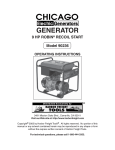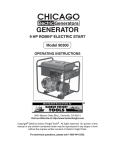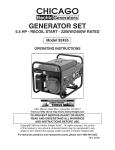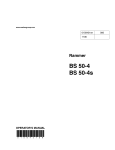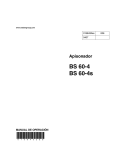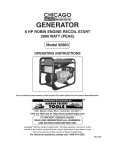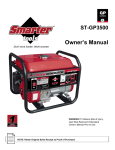Download Chicago Electric 94678 User's Manual
Transcript
2.5 Horsepower Gas engine generator 94678 Installation And Operation Instructions Due to continuing improvements, actual product may differ slightly from the product described herein. Distributed exclusively by Harbor Freight Tools®. 3491 Mission Oaks Blvd., Camarillo, CA 93011 Visit our website at: http://www.harborfreight.com To prevent serious injury, read and understand all warnings and instructions before use. Copyright© 2006 by Harbor Freight Tools®. All rights reserved. No portion of this manual or any artwork contained herein may be reproduced in any shape or form without the express written consent of Harbor Freight Tools. For technical questions or replacement parts, please call 1-800-444-3353. Contents Unpacking................................................................................................ 2 Specifications.......................................................................................... 3 General Safety Rules............................................................................... 4 Specific Safety Rules.............................................................................. 6 Generator Control Illustrations.............................................................. 9 Installation Instructions.......................................................................... 9 Operation Instructions........................................................................... 11 Pre-start Checks:................................................................................................. 11 To Start the Engine:............................................................................................. 11 To Power 120 Volt AC Tools and Equipment:.................................................... 11 To Charge 12 V Lead-acid Type Batteries:......................................................... 12 Inspection, Maintenance, and Cleaning............................................... 13 Troubleshooting...................................................................................... 14 Parts List - Engine.................................................................................. 15 Assembly Diagram - Engine.................................................................. 16 Parts List A - Generator......................................................................... 17 Assembly Diagram A - Generator......................................................... 18 Emission Control System Warranty...................................................... 19 Warranty.................................................................................................. 20 Unpacking When unpacking, check to make sure that the item is intact and undamaged. If any parts are missing or broken, please call Harbor Freight Tools at the number shown on the cover of this manual as soon as possible. SKU 94678 For technical questions, please call 1-800-444-3353. Page Specifications Generator Type Brushless / Revolving Field / Self Exciting / Two Pole / Single Phase Wattage 1,000 / 1,050 (Continuous-Rated/Peak) Electrical Output 110/120 V~, 60 Hz about 18 V (12 V battery charging) Electrical Supply 120 V~, 3-Prong Grounded Duplex Receptacle with 10 Amp Resettable Circuit Protection 12 V Battery-charging Output* with 10 Amp Resettable Circuit Protection *Only for use with included power cord for 12 V battery charging. Voltmeter 0-300 V~ Total Weight 57 lb. Engine Type 2.5 HP / Unleaded Gasoline Powered / Recoil Start / 4-Cycle / Air-Cooled 98 cc Displacement / Low Oil Shutdown / CARB and EPA Certified Estimated Run Time 5.5 Hours on full tank Engine Oil Type SAE 10W-30 (for general, all temperature use) Engine Oil Capacity 0.47 Quart (0.45 Liter) Fuel Tank Capacity about 1.2 Gallons Spark Plug Gap 0.6-0.7 mm Recommended Spark Plugs L6RTF, BM4A, BMR4A������ (NGK) Only use these types. An incorrect spark plug may damage the engine. Bore x Stroke 52 x 46 mm PTO Shaft Rotation Counterclockwise Facing The Shaft WARNING: This product requires oil and fuel to be added before starting. Attempting to start the engine without oil will ruin the engine and VOID the warranty! Caution: This generator is not intended to power sensitive electronic equipment without the addition of an appropriate line conditioner (not included or sold by Harbor Freight Tools). The Emission Control System for this generator’s engine is warranted for standards set by the U.S. Environmental Protection Agency and by the California Air Resources Board (also known as CARB). For warranty information, refer to the back two pages of this manual. Save This Manual You will need this manual for the safety warnings and precautions, assembly, operating, inspection, maintenance and cleaning procedures, parts list and assembly diagram. Keep your invoice with this manual. Write the invoice number on the inside of the front cover. Write the product’s serial number in the back of the manual near the assembly diagram, or write month and year of purchase if product has no number. Keep this manual and invoice in a safe and dry place for future reference. REV 07g SKU 94678 For technical questions, please call 1-800-444-3353. Page General Safety Rules WARNING! READ AND UNDERSTAND ALL INSTRUCTIONS Failure to follow all instructions listed below may result in electric shock, fire, and/or serious injury. SAVE THESE INSTRUCTIONS Work Area 1. Keep your work area clean and well lit. Cluttered benches and dark areas invite accidents. 2. Do not operate equipment in explosive atmospheres, such as in the presence of flammable liquids, gases, or dust. Equipment create sparks which may ignite the dust or fumes. 3. Keep bystanders, children, and visitors away while operating a equipment. Distractions can cause you to lose control. Protect others in the work area from debris such as chips and sparks. Provide barriers or shields as needed. Electrical Safety 1. Avoid body contact with grounded surfaces such as pipes, radiators, ranges, and refrigerators. There is an increased risk of electric shock if your body is grounded. 2. Do not expose equipment to rain or wet conditions. Water entering a equipment will increase the risk of electric shock. 3. Do not abuse Power Cords. Never use a Power Cord to pull a Plug from the outlet. Keep all Power Cords away from heat, oil, sharp edges, or moving parts. Replace damaged Power Cords immediately. Damaged Power Cords increase the risk of electric shock. Personal Safety 1. Stay alert. Watch what you are doing, and use common sense when operating a equipment. Do not use a equipment while tired or under the influence of drugs, alcohol, or medication. A moment of inattention while operating equipment may result in serious personal injury. 2. Dress properly. Do not wear loose clothing or jewelry. Contain long hair. Keep your hair, clothing, and gloves away from moving parts. Loose clothes, jewelry, or long hair can be caught in moving parts. Be aware that when engine parts are moving fast they cannot be seen clearly. SKU 94678 For technical questions, please call 1-800-444-3353. Page 3. Remove adjusting keys or wrenches before turning the equipment on. A wrench or a key that is left attached to a rotating part of the equipment may result in personal injury. 4. Do not overreach. Keep proper footing and balance at all times, especially when starting the equipment. 5. Use safety equipment. Always wear eye protection. Dust mask, nonskid safety shoes, hard hat, or hearing protection must be used for appropriate conditions. Always wear ANSI-approved safety goggles when using or performing maintenance on this equipment. Equipment Use And Care 1. Do not force the equipment. Use the correct equipment for your application. The correct equipment will do the job better and safer at the rate for which it is designed. Do not force the equipment and do not use the equipment for a purpose for which it is not intended. 2. Do not use the equipment if the Power Switch does not turn it on or off. Any equipment that cannot be controlled with the Power Switch is dangerous and must be replaced. 3. Turn the power switch and the fuel supply to off and unplug the spark plug wire before making any adjustments, changing accessories, or storing the equipment. Such preventive safety measures reduce the risk of starting the equipment accidentally. 4. Store idle equipment out of reach of children and other untrained persons. Equipment is dangerous in the hands of untrained users. 5. Maintain equipment with care. Do not use a damaged equipment. Tag damaged equipment “Do not use” until repaired. 6. Check for misalignment or binding of moving parts, breakage of parts, and any other condition that may affect the equipment’s operation. If damaged, have the equipment serviced before using. Many accidents are caused by poorly maintained equipment. 7. Use only accessories that are recommended by the manufacturer for your model. Accessories that may be suitable for one piece of equipment may become hazardous when used on another piece of equipment. Service 1. Equipment service must be performed only by qualified repair personnel. Service or maintenance performed by unqualified personnel could result in a risk of injury. SKU 94678 For technical questions, please call 1-800-444-3353. Page 2. When servicing a equipment, use only identical replacement parts. Follow instructions in the “Inspection, Maintenance, And Cleaning” section of this manual. Use of unauthorized parts or failure to follow maintenance instructions may create a risk of electric shock or injury. 3. Do not alter or adjust any part of the equipment or its engine that is sealed by the manufacturer or distributor. Only a qualified service technician may adjust parts that may increase or decrease governed engine speed. Specific Safety Rules 1. Maintain labels and nameplates on the generator. These carry important information. If unreadable or missing, contact Harbor Freight Tools for a replacement. 2. WARNING! People with pacemakers should consult their physician(s) before using this product. Electromagnetic fields in close proximity to a heart pacemaker could cause interference to or failure of the pacemaker. 3. Avoid body contact with fuels, oils, and lubricants used in the Generator. If swallowed, seek medical treatment immediately. Do not induce vomiting if fuel is swallowed. For skin contact, immediately wash with soap and water. For eye contact, immediately flush eyes with clean water. 4. Prolonged exposure to noise levels above 85 dBA is hazardous to hearing. Always wear ANSI-approved hearing protection when operating or working around the Generator when it is running. 5. Lifting/transport precautions. Never lift the Generator using the engine or alternator lifting lugs. Connect lifting equipment only to the Frame of the Generator. Before lifting the Generator, ensure the lift rigging and supporting structure are in good condition, and are rated to lift such a load. Keep all personnel away from the suspended generator while relocating. 6. WARNING! Some dust created by power sanding, sawing, grinding, drilling, and other construction activities, contain chemicals known (to the State of California) to cause cancer, birth defects or other reproductive harm. Some examples of these chemicals are: • Lead from lead-based paints. • Crystalline silica from bricks and cement or other masonry products. • Arsenic and chromium from chemically treated lumber. Your risk from these exposures varies, depending on how often you do this type of work. To reduce your exposure to these chemicals: work in a well-ventilated area, and work with approved safety equipment, such as those dust masks that are specially designed to filter out microscopic particles. (California Health & Safety Code § 25249.5, et seq.) REV 07l SKU 94678 For technical questions, please call 1-800-444-3353. Page INSTALLATION PRECAUTIONS 1. Ensure installation meets all applicable safety, and local and national electrical codes. Have installation performed by a qualified, licensed electrician and building contractor. 2. All electrical work, including the earth-ground connection, should be completed by a licensed electrician. 3. If the generator is installed indoors, exhaust fumes must be piped out of the building using leak-free, heat-resistant piping. Use the Generator only in well ventilated outdoor areas. Carbon monoxide fumes are a colorless, odorless gas that, if inhaled, can cause serious injury or death. Pipes and silencer should not use any flammable materials, nor should they be installed near the same. Generator exhaust fumes must be within legal limits. 4. If the generator is installed outdoors, it must be weatherproofed and should be soundproofed. It should not be run outdoors without protection to the Generator and wiring conduit. Install sound- and weather-proofing only when it is not raining or snowing to avoid trapping moisture within the Generator’s area. 5. The supporting floor/ground surface should be level, and strong enough to safely hold the weight of the Generator. If the floor/ground surface is not level, strong cross members should be placed under the full length of the Generator Frame at its low side. 6. For trailer installation, the Generator should be mounted on the center point of the trailer, over the wheels. FIRE AND EXPLOSION PRECAUTIONS 1. Gasoline fuel and fumes are flammable, and potentially explosive. Use proper fuel storage and handling procedures. Always have multiple ABC class fire extinguishers nearby. 2. Keep the Generator and surrounding area clean at all times. 3. When spills of fuel or oil occur, they must be cleaned up immediately. Dispose of fluids and cleaning materials as per any local, state, or federal codes and regulations. Store oil rags in a covered metal container. 4. Never store fuel or other flammable materials near the Generator. 5. Do not smoke, or allow sparks, flames or other sources of ignition around the Engine and Fuel Tank. Keep grounded conductive objects, such as tools, away from exposed, live electrical parts and connections to avoid sparking or arcing. SKU 94678 For technical questions, please call 1-800-444-3353. Page 6. Do not refill the Fuel Tank while the Engine is running or while the Engine is still hot. Do not operate the Generator with known leaks in the fuel system. 7. Excessive buildup of unburned fuel gases in the exhaust system can create a potentially explosive condition. This buildup can occur after repeated failed start attempts, valve testing, or hot engine shutdown. If this occurs, open exhaust system drain plugs, if equipped, and allow the gases to dissipate before attempting to restart the Generator. 8. Any separate Generator fuel storage facility must be built/installed in full compliance with all relevant local, state, and federal regulations. MECHANICAL PRECAUTIONS Do not operate the Generator with safety guards removed. While the Generator is running, do not attempt to reach around the safety guards for any reason. ELECTRICAL PRECAUTIONS 1. All connections and conduits from the Generator to the load must only be installed by trained and licensed electricians, and in compliance with all relevant local, state, and federal electrical codes and standards, and other regulations where applicable. 2. The Generator must be earth-grounded in accordance with all relevant electrical codes and standards before operation. 3. Do not attempt to connect or disconnect load connections while standing in water, or on wet or soggy ground. 4. Insulate all connections and disconnected wires. Do not touch electrically energized parts of the Generator and interconnecting cables or conductors with any part of the body, or with any non-insulated conductive object. 5. Connect the generator only to a load or electrical system (110/120 volt) that is compatible with the electrical characteristics and rated capacities of the Generator. 6. Before servicing equipment powered by the Generator, disconnect the equipment from its power input. 7. Keep all electrical equipment clean and dry. Replace any wiring where the insulation is cracked, cut, abraded or otherwise degraded. Replace terminals that are worn, discolored, or corroded. Keep terminals clean and tight. 8. Keep access doors on enclosures closed and locked when access is not required. 9. Keep all electrical cords away from moving parts on the generator. SKU 94678 For technical questions, please call 1-800-444-3353. Page 10. This Generator provides raw, unregulated output to the battery charging outlet. Incorporating an inline regulator is strongly recommended while charging and the charging process must be monitored at all times. The battery charging output must not be used to power any other device or charge any other type of battery without a proper regulating device. Installation Instructions 1. Prior to powering tools and equipment, make sure the Generator’s rated wattage capacity (1000 W) is adequate to supply all electrical loads that the unit will power. If powering exceeds the Generator’s capacity, it may be necessary to group one or more of the tools and/or equipment for connection to a separate Generator. 2. Electrical and other permits may be required for the installation of emergency power systems. Investigate the local building and electrical codes before installing this unit. Installation must be completed by licensed contractors. GENERAL LOCATION 1. It is recommended to locate and install the Generator outdoors where cooling air is readily available. 2. Install the Generator so that the air inlets and outlets are not blocked by obstructions such as bushes, trees, or snow drifts. Locating it in the path of heavy winds or snowdrifts may require the placement of a barrier for protection. The air inlet, in normal weather conditions, should face the prevailing wind direction. 3. Install the Generator on a concrete slab or other area where rain drainage or flood waters can not reach it. 4. Generator placement should allow four feet of access to all sides for maintenance. 5. Place the Generator as close as possible to the electrical tools and equipment being powered to reduce the length of extension cords. 6. If the Generator in located indoors the Engine exhaust must be ventilated to the outdoors using leakproof, heat resistant, flexible, metal, flex tubing. GROUNDING THE GENERATOR Note: It is recommended that only a trained and licensed electrician perform this procedure. Connect a #6 AWG grounding wire (not included) from the Grounding Point (55a) on the Generator to a grounding rod (not included) that has been driven at least 24 inches deep into the earth. The grounding rod must be an earth-driven copper or brass rod (electrode) which can adequately ground the Generator. SKU 94678 For technical questions, please call 1-800-444-3353. Page Generator Control Illustrations Fuel Meter (1a) Choke Control (80) Air Filter Cover (67) transparent to show controls underneath. Oil Drain Plug (24) Fuel Valves (9a, 81) Recoil Start Handle (64) ON/OFF Switch (52a) Circuit Protectors DC (59a)AC (53a) Battery Charging Dipstick Outlet (57a) (28) AC Outlets Pilot Lamp (54a) (56a) Voltmeter (58a) Grounding Point (55a) Before setting up or using the generator, familiarize yourself with the locations of the controls and adjustments as shown above. Operation Instructions Note: For additional information regarding the parts listed in the following pages, refer to the Assembly Diagrams on pages 16 and 18 and the Generator Control Illustrations above. Pre-start Checks: 1. Check to make sure the Engine’s Power Switch (52a) is in its “OFF” position. 2. IMPORTANT! Prior to first using the Generator, the Engine MUST be filled with approximately 1/2 (0.47) quart of a high quality SAE 10W-30 grade engine oil. To do so, unscrew and remove the Engine’s Oil Dipstick (28) located at the bottom of the Engine Crankcase. Fill the Engine’s Crankcase until the oil level is up to the upper marked line on the Dipstick. Then, screw the Dipstick back into the Oil Fill Hole. 3. Before use, remove the Fuel Tank Cap (2a) and fill the Fuel Tank (8a) with unleaded gasoline. Then, replace the Fuel Tank Cap. SKU 94678 For technical questions, please call 1-800-444-3353. Page 10 To Start the Engine: 1. Make sure the electrical tools/equipment that will be used are not plugged in to the Generator. 2. Turn on the Fuel Valves (9a, 81). Turn the Valve (9a) under the fuel tank to the vertical ON position and swing the Valve (81) on the carburetor behind the Air Filter right to the ON position. 3. Close the Choke Control (80), swinging it to the left. 4. Turn the ON/OFF Switch (52a) to its “ON” position. 5. Hold the Start Handle (64) loosely and pull it slowly several times to allow the gasoline to flow into the Engine’s carburetor. Then hold the Start Handle firmly and pull the rope hard and fast. Pull the rope all the way out, using two hands if necessary. If necessary pull the rope several times until the Engine starts. The red Pilot Lamp (56a) will illuminate while the generator is able to supply power. 6. Allow the Engine to run for several seconds. Open the Choke Control (80) swinging it to the right. To Power 110/120 Volt AC Tools and Equipment: 1. Prior to powering tools and equipment, make sure the Generator’s rated wattage capacity (1000 W) is adequate to supply all electrical loads that the unit will power. If powering exceeds the Generator’s capacity, it may be necessary to group one or more of the tools and/or equipment for connection to a separate Generator. 2. Only start the Generator with no loads attached. Once the Generator is running, simply connect the Power Cords of 110/120 volt AC powered tools and equipment into the 110/120 volt AC Outlets (54a). NOTE: The Generator features an AC Circuit Protector (53a) to protect the AC circuit in case of an overload. Should an overload occur the Breaker will “trip” to its “OFF” position, causing the Generator to automatically shut down and the Pilot Light (56a) on the control panel will shut off to show that the Circuit Protector (53a) has been tripped. For details on preventing this problem, refer to Step #1 above in this section. Then, reset the circuitry system by pressing on the Circuit Protector. 3. When finished using the Generator, turn the ON/OFF Switch (52a) to its “OFF” position. Turn the Fuel Valves (9a, 81) to their “OFF” positions. Then, disconnect all electrical powered tools and equipment from the Generator’s 110/120 volt AC Outlets (53a). 4. After the Engine and Generator have completely cooled, store the Generator in a safe, clean, dry location (if not already installed in one). SKU 94678 For technical questions, please call 1-800-444-3353. Page 11 To Charge 12 V Lead-acid Type Batteries: Note:Lead-acid batteries can be hazardous. Carefully follow all instructions, safety precautions, and charging procedures as included with the battery you will recharge. Batteries contain corrosive acid that can cause blindness or severe injury; always wear splash-resistant ANSI-approved safety goggles and work gloves when handling batteries. Also, have a nearby area with water and baking soda available to allow you to wash quickly in the event of an emergency. Wash thoroughly after working on or near batteries. 1. Only start the Generator with no loads attached. Once the Generator is running, with the Charging Plug (60a) disconnected, connect the Charging Battery Clamps (60a) to the terminals (red clamp to positive, + terminal, and black clamp to negative, – terminal) of the 12 V lead-acid battery to be charged if a regulator is not available. This Generator provides raw output to the battery charging outlet that is not regulated; incorporating an inline regulator is strongly recommended while charging. 2. To start the charging process, connect the Charging Plug (60a) to the Battery Charging Outlet (57a). Do not leave the battery unattended while it is charging. NOTE: The Generator features a DC Circuit Protector (59a) to protect the DC circuit in case of an overload. Should an overload occur the Breaker will “trip” to its “OFF” position, causing the Generator to automatically shut down and the Pilot Light (56a) on the control panel will shut off to show that the Circuit Protector (59a) has been tripped. This problem may be caused by a defective battery, a large or high capacity battery that needs to be charged by another means, or other problems. Reset the circuitry system by pressing on the Circuit Protector. 3. Periodically disconnect the Charging Plug (60a) and check the battery’s voltage. Stop charging the battery when the battery’s voltage reaches the manufacturer’s recommended voltage (typically 13.5 V or less). Overcharging can result in fire, explosion, or serious personal injury. If the battery is not charged enough, reconnect the Charging Plug (60a). 4. Disconnect the plug from the generator’s charging outlet first, then disconnect the clamps from the battery. SKU 94678 For technical questions, please call 1-800-444-3353. Page 12 Inspection, Maintenance, and Cleaning (See maintenance chart on next page.) 1. WARNING! Make sure the Power Switch of the generator is in its “OFF” position, that the engine has cooled, and that all loads are unplugged from the electrical outlets before performing any inspection, maintenance, or cleaning procedures. 2. BEFORE EACH USE, inspect the general condition of the generator. Check for loose screws, misalignment or binding of moving parts, cracked or broken parts, damaged electrical wiring, and any other condition that may affect its safe operation. If abnormal noise or vibration occurs, have the problem corrected before further use. Do not use damaged equipment. 3. To clean the air filter: While wearing a NIOSH-Approved dust mask/respirator, remove the Air Filter Cover (67) and remove the Foam Filter (69) underneath. If it is ragged or has holes, it will need to be replaced. Rinse the filter out by hand with mild soap and water. Allow it to dry thoroughly before replacing it and reassembling the Air Filter Cover (67). 4. TO REMOVE THE SPARK PLUG: WARNING! To access the spark plug, the Fuel Tank (8a) must be removed. Carefully make sure that the engine is thoroughly cool, that no ignition sources (including lit cigarettes) are nearby, that rags for cleaning up spills and a class ABC fire extinguisher is nearby, and that you have a suitable place to temporarily put the gas tank during work. a. First, make sure that the Fuel Valves (9a, 81) are both turned to their OFF positions. Secure the Fuel Valve (9a) under the Fuel Tank closed using a string or cable tie if possible. b. Have a rag ready to promptly clean up the small amount of fuel that will spill and disconnect the fuel line from the Fuel Valve (9a) under the Fuel Tank (8a). Use a small cap to cover the end of the fuel valve to prevent debris from entering. c. Remove the four Bolts (4a) and other hardware from the corners of the Fuel Tank (8a). Make sure to note the order of the hardware that secures the Fuel Tank to the Frame – it is important that the fuel tank is reinstalled in the same fashion. d. Gently remove the Fuel Tank and set it aside without tipping it, being careful not to damage the Fuel Valve under the Tank. e. Now you have access to remove the Spark Plug (44) without difficulty. Carefully check that the spark plug and wire are both in good condition and securely attached before reassembly. f. Reassembly is the reverse of the earlier steps. Take note that the Fuel Tank must be reinstalled with the Fuel Gauge in the same orientation as originally (see illustrations on page 9). The fuel tank should fit in place without contacting any engine or alternator components. SKU 94678 For technical questions, please call 1-800-444-3353. Page 13 Maintenance Chart Refer to a small engine service manual for procedures not explained in this manual. If you are uncertain about your ability to successfully and safely perform any procedure below, service should be performed by a qualified mechanic. Maintenance Type Before/ After Each Use 1. Check Engine Oil Level 2. Inspect for damage 3. Wipe off outside with clean, slightly moist cloth Monthly or 20 hours Every 3 Months or 50 hours Every 6 Months or 100 hours Yearly or 300 hours X X X X X X X X X X 1. Change Engine Oil 2. Clean Air Filter (69) (Replace Filter as needed) Clean Deposit Cup (76) (Clean monthly in dusty areas) Clean Spark Plug (44) (Replace as needed) Engine Overhaul Refer to a small engine service manual for procedures. Service is to be performed only by a qualified mechanic and includes: X 1. Valve Clearance Check/Adjust 2. Clean Combustion Chamber 3. Clean Fuel Tank, Filter, and Supply Line (replace filter and line as needed) Troubleshooting Problem Possible Causes Engine will not start Engine is running, but power is not being supplied to outlets. SKU 94678 Probable Solutions 1. Fuel Tank empty. 1. Check fuel level at Fuel Meter (1a). 2. Fuel Valve(s) closed. 2. Put Valves (9a, 81) in ON position. 3. Choke not in proper start position. 3. Move Choke Control left to start. 4. ON/OFF Switch off. 4. Turn switch to ON position. 5. Oil level low. 5. Check engine oil level. 6. Spark Plug damaged, gapped incorrectly, or connected improperly. 6. Check Spark Plug gap, condition, and connection. 7. Mechanical/electrical problem. 7. Have qualified mechanic inspect and repair. 1. Circuit Protection (59a, 53a) tripped. Pilot Light (56a) will be off. 1. Reduce electrical load and reset Circuit Protection (53a). 2. Electrical problem. 2. Have a qualified technician service unit. For technical questions, please call 1-800-444-3353. Page 14 Parts List - Engine Part Description Q’ty Part 1 2 3 4 5 6 7 8 9 10 11 12 13 14 15 16 17 18 19 20 21 22 23 24 25 26 27 28 29 30 31 32 33 34 35 36 37 38 39 40 41 Crankcase Valve chamber clapboard sub-assy Stud M5 × 118 Stud M6 × 52 Oil seal (17×30×6), crankshaft Cover, oil filter Gasket Return pipe Flow guard, lower Sway bar Keeper, sway bar Oil seal, sway bar Washer, sway bar Bolt M6 × 14 Bolt M5 × 10 Crankshaft sub-assy Connecting rod Piston Piston pin Circlip, piston pin Piston ring set Set pin Ø8 × 14 Gasket, crankcase Drain plug Washer Crankcase cover Oil seal (17×30×6), crankshaft Dipstick sub-assy Oil plug sub-assy Driven gear sub-assy, governor Bearing 6203 Bolt M6 × 29 Camshaft Washer, camshaft Tappet Intake valve Exhaust valve Oil seal, valve stem Spring seat, valve Valve spring Cap 1 1 2 2 1 1 1 1 1 1 1 1 1 2 4 1 1 1 1 2 1 2 1 2 2 1 1 1 1 1 1 6 1 2 2 1 1 1 2 2 2 42 43 44 45 46 47 48 49 50 51 52 53 54 55 56 57 58 59 60 61 62 63 64 65 66 67 68 69 70 71 72 73 74 75* 76* 77* 78 79 80* 81* SKU 94678 Description Q’ty Gasket, cylinder head Cylinder cover Spark plug Bolt M6 × 35 Gasket, intake port Carburetor assy. Connecting block Gasket, carburetor Governor arm Pull-rod, governor Lock bolt Return spring Assistant spring, governor Mount, governor Nut M6 Ignition coil/Spark plug wire assy. Bolt M6 × 27 Fan, flywheel Starting flange Flywheel Nut M12 × 1.25 Fan hood sub-assy Recoil starter Bolt M6 × 8 Bolt M6 × 14 Cover, air filter Housing, air filter Foam, air filter Bracket, air filter Gasket, air filter Nut M6 Pan screw M6 × 10 Washer 5 O-ring Deposit Cup Carburetor Drain Plug Spark Plug Socket Socket Handle Choke Control Fuel Valve 1 1 1 6 1 1 1 1 1 1 1 1 1 1 2 1 2 1 1 1 1 1 1 3 3 1 1 1 1 1 2 4 4 1 1 1 1 1 1 1 *Part of Carburetor assy. (47) For technical questions, please call 1-800-444-3353. Page 15 Assembly Diagram - Engine SKU 94678 For technical questions, please call 1-800-444-3353. Page 16 Parts List A - Generator Part 1a 2a 3a 4a 5a 6a 7a 8a 9a 10a 11a 12a 13a 14a 15a 16a 17a 18a 19a 20a 21a 22a 23a 24a 25a 26a 27a 28a 29a 30a Description Fuel Meter Fuel Tank Cap Fuel Tank Filter Flange Bolt M6 x 20 Gasket Screw Gasket Anti-vibration Gasket Fuel Tank Fuel Valve Fuel Pipe Clamp Oil Pipe Engine (See parts list on earlier page) Exhaust Pipe Gasket Exhaust Pipe Lock Nut M8 Flange Bolt M6 x 12 Muffler Gasket B Muffler Flange Bolt M6 x 12 Front Cover Gasket Flange Bolt M8 x 20 Rotor Assembly Stator Assembly Wiring Cover Rear Cover Rectifier Gasket Spring Gasket Bolt Q’ty Part 1 1 1 4 4 4 4 1 1 2 1 1 1 1 2 2 1 1 1 1 4 4 1 1 1 1 1 4 4 4 31a 32a 33a 34a 35a 36a 37a 38a 39a 40a 41a 42a 43a 44a 45a 46a 47a 48a 49a 50a 51a 52a 53a 54a 55a 56a 57a 58a 59a 60a Description Gasket Spring Gasket Bolt M8 x 170 Magneto Cover Gasket Spring Gasket Bolt M5 x 8 Lock Nut M8 Gasket Spring Gasket Bolt M8 x 40 Cushion Frame Anti-vibration Feet Flex Tube Circuit Cover Bolt M4 x 10 Capacitor Bolt M4 x 16 Panel Bolt M6 x 25 Engine Switch AC Circuit Protector AC Outlet Grounding Point Pilot Lamp Battery Charging Socket Voltmeter DC Circuit Protector Battery Charging Cord Q’ty 1 1 1 1 2 2 2 6 8 8 8 2 1 4 1 1 2 1 1 1 4 1 1 2 1 1 1 1 1 1 PLEASE READ THE FOLLOWING CAREFULLY The manufacturer and/or distributor has provided the parts list and assembly diagram in this manual as a reference tool only. Neither the manufacturer or distributor makes any representation or warranty of any kind to the buyer that he or she is qualified to make any repairs to the product, or that he or she is qualified to replace any parts of the product. In fact, the manufacturer and/or distributor expressly states that all repairs and parts replacements should be undertaken by certified and licensed technicians, and not by the buyer. The buyer assumes all risk and liability arising out of his or her repairs to the original product or replacement parts thereto, or arising out of his or her installation of replacement parts thereto. SKU 94678 For technical questions, please call 1-800-444-3353. Page 17 Assembly Diagram A - Generator Record Product’s Serial Number Here: Note: If product has no serial number, record month and year of purchase instead. Note: Some parts are listed and shown for illustration purposes only, and are not available individually as replacement parts. SKU 94678 For technical questions, please call 1-800-444-3353. Page 18 Emission Control System Warranty California and United States Emission Control Defects Warranty Statement The California Air Resources Board (herein CARB), the United States Environmental Protection Agency (herein EPA), and Harbor Freight Tools® (herein HFT) are pleased to explain the emission control system warranty on your 1995 and later Small Off-Road Engine (herein engine). In California, the engine must be designed, built and equipped to meet the State’s stringent anti-smog standards. Elsewhere within the United States, new off-road, spark-ignition engines certified for model year 1997 and later, must meet similar standards set forth by the EPA. HFT must warrant the emission control system on your engine for the periods of time described below, provided there has been no abuse, neglect or improper maintenance of your engine. Your emission control system may include parts such as the carburetor or fuel-injection system, and the ignition system. Also included may be hoses, belts, connectors and other emissionrelated assemblies. Where a warrantable condition exists, HFT will repair your engine at no cost to you including diagnosis, parts and labor. Manufacturer’s Warranty Coverage The 1995 and later engines are warranted for two (2) years. If any emission-related part on your engine is defective, the part will be repaired or replaced by HFT. Harbor Freight Tools Emission Control Defects Warranty Coverage Engines are warranted for a period of two (2) years relative to emission control parts defects, subject to the provisions set forth below. If any emission related part on your engine is defective, the part will be repaired or replaced by HFT. Owner’s Warranty Responsibilities - As the engine owner, you are responsible for the performance of the required maintenance listed in your Owner’s Manual. HFT recommends that you retain all receipts covering maintenance on your engine, but HFT cannot deny warranty solely for the lack of receipts or for your failure to ensure the performance of all scheduled maintenance. - As the engine owner, you should, however, be aware that HFT may deny you warranty coverage if your engine or a part has failed due to abuse, neglect, improper maintenance, or unapproved modifications. - You are responsible for shipping your engine to a HFT warranty station as soon as a problem exists. Contact the HFT Customer Service department at the number below to make shipping arrangements. The warranty repairs should be completed in a reasonable amount of time, not to exceed 30 days. If you have any questions regarding your warranty rights and responsibilities, you should contact the Harbor Freight Tools Customer Service Department at 1-800-444-3353. SKU 94678 Harbor Freight Tools Emission Control Defects Warranty Provisions 1.Length of Coverage HFT warrants to a first retail purchaser and each subsequent purchaser that the engine is free from defects in materials and workmanship that cause the failure of warranted parts for a period of two (2) years after the date of delivery to the first retail purchaser. 2.No Charge Repair or Replacement Repair or replacement of any warranted part will be performed at no charge to the owner if the work is performed through a warranty station authorized by HFT. For emissions warranty service, contact the HFT Customer Service Department at 1-800-444-3353. 3.Consequential Damages Coverage Coverage under this warranty shall also extend to the failure of any engine components caused by the failure of any warranted part while it is still covered under this warranty. 4.Coverage Exclusions Warranty claims shall be filed in accordance with the provisions of the HFT warranty policy explained in the box at the top of the previous page. HFT shall not be liable for any loss of use of the engine, for any alternative usage, for any damage to goods, loss of time, or inconvenience. Warranty coverage shall also be excluded for any part which fails, malfunctions, or is damaged due to failure to follow the maintenance and operating instructions set forth in the Owner’s Manual including, but not limited to: (a) use of parts which are not authorized by HFT (b) improper installation, adjustment or repair of the engine or of any warranted part unless performed by an authorized warranty center (c) failure to follow recommendations on fuel use contained in the Owner’s Manual (d) improper or inadequate maintenance of any warranted parts (e) repairs performed outside of the authorized warranty service dealers (f) alterations by changing, adding to or removing parts from the engine. 5.Service and Maintenance Component parts which are not scheduled for replacement as required maintenance or are scheduled only for regular inspection to the effect of “repair or replace as necessary” are warranted for the warranty period. Any warranted part which is scheduled for replacement as required maintenance is warranted for the period of time up to the first scheduled replacement point for that part. Any replacement part, provided it is equivalent in durability and performance, may be used in performance of maintenance or repairs. The owner is responsible for commissioning a qualified technician/mechanic to perform all required maintenance, as outlined in the Maintenance and Cleaning sections on page 13-14 of this manual. For technical questions, please call 1-800-444-3353. Page 19 6.Warranted Parts 1)Fuel Metering System i) Carburetor and its internal parts. ii) Fuel pump (if so equipped). iii) Cold start enrichment system. 2)Air Induction System i) Intake pipe/manifold. ii) Air cleaner. 4)Catalyst System (if so equipped) i) Exhaust pipe stud. ii) Muffler. iii) Catalytic converter (if so equipped). 5) Miscellaneous items Used in Above Systems i) Vacuum, temperature and time sensitive valves and switches. ii) Hoses, belts, connectors, and assemblies. 3)Ignition System i) Spark plug. ii) Magneto ignition system. Warranty Limited 1 year warranty Harbor Freight Tools Co. makes every effort to assure that its products meet high quality and durability standards, and warrants to the original purchaser that this product is free from defects in materials and workmanship for the period of one year from the date of purchase (90 days if used by a professional contractor or if used as rental equipment). This warranty does not apply to damage due directly or indirectly, to misuse, abuse, negligence or accidents, repairs or alterations outside our facilities, or to lack of maintenance. We shall in no event be liable for death, injuries to persons or property, or for incidental, contingent, special or consequential damages arising from the use of our product. Some states do not allow the exclusion or limitation of incidental or consequential damages, so the above limitation of exclusion may not apply to you. This warranty is expressly in lieu of all other warranties, express or implied, including the warranties of merchantability and fitness. To take advantage of this warranty, the product or part must be returned to us with transportation charges prepaid. Proof of purchase date and an explanation of the complaint must accompany the merchandise. If our inspection verifies the defect, we will either repair or replace the product at our election or we may elect to refund the purchase price if we cannot readily and quickly provide you with a replacement. We will return repaired products at our expense, but if we determine there is no defect, or that the defect resulted from causes not within the scope of our warranty, then you must bear the cost of returning the product. This warranty gives you specific legal rights and you may also have other rights which vary from state to state. 3491 Mission Oaks Blvd. • PO Box 6009 • Camarillo, CA 93011 • (800) 444-3353 SKU 94678 For technical questions, please call 1-800-444-3353. Page 20




















